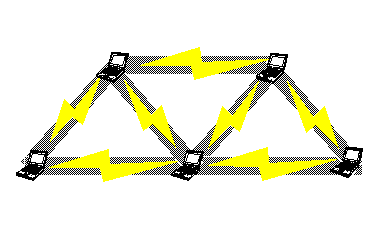
DIME will extend the TCP/IP protocol suite to support dynamically self-configuring wireless networks that will enable a new generation of distributed measurement systems, e.g. non-intrusive determination of building integrity after an earthquake. Each node of a DIME network will detect its location in the physical world, and logical network topology on startup. DIME will also provide tight temporal synchronization between nodes to facilitate distributed event reporting, which is an integral part of distributed measurement and simulation systems. Because many DIME networks will be used in bandwidth intensive applications, they must optimize the use of that bandwidth to the task at hand.
DIME was part of USC/ISI’s Teranode Network Technology project.
- Algorithms will be designed to allow DIME nodes to determine their location in physical space as well as network topologies. Since nodes may leave or join at any time while a tightly coupled application is running, the system must be able to detect and manage changes in topology. Such autoconfiguration algorithms will take cues from existing host configuration and mobile computing algorithms, where applicable. New challenges for these algorithms include their fully decentralized nature, and their need to determine physical position of the nodes. These new aspects make quickly deployable measurement or support applications possible.
- Temporal synchronization protocols must be designed, particularly for distributed measurement. Correlating events that happen at two sensors makes distributed measurement feasible. Furthermore, new nodes entering a system should be integrated as quickly as possible, because their information is of questionable value until synchronized. Current time synchronization algorithms must be extended to the DIME environment.
- Bandwidth allocation algorithms must be designed. Many of the applications are very high bandwidth but exhibit application dependent locality. A dynamically configured disaster relief network should reserve bandwidth for hospital units, for example. The protocols will be demonstrated using a simple data measurement application. If possible, the algorithms will also be tested in a structural integrity sensing application developed in conjunction with the University of Southern California’s Civil Engineering department which will be deployed on the Vincent Thomas Bridge.
